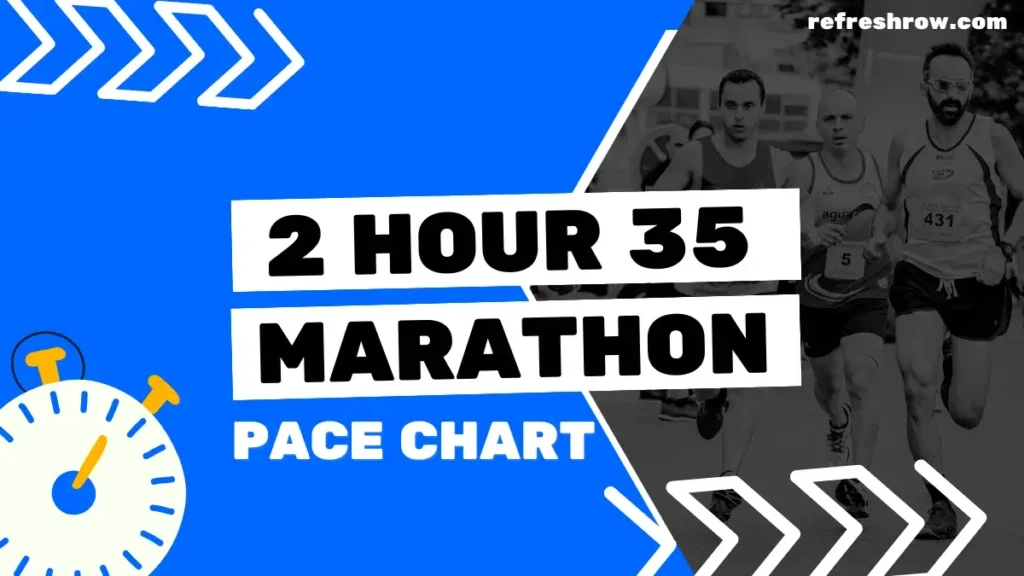To run a 4:55 hour marathon you need to run at a pace of 11:15 per mile or 6:59 per kilometer.
Following the splits below (and shaving off a second), you’ll run a sub 4:55 marathon.
I’d recommend aiming to run 1-2 minutes ahead of the split target time from 10 miles, as you’ll likely come up against crowding on race day.
4:55 Marathon Pace in Miles
| Mile | Split |
|---|---|
| 1 | 11:15 |
| 2 | 22:30 |
| 3 | 33:45 |
| 4 | 45:00 |
| 5 | 56:15 |
| 6 | 1:07:31 |
| 7 | 1:18:46 |
| 8 | 1:30:01 |
| 9 | 1:41:16 |
| 10 | 1:52:31 |
| 11 | 2:03:46 |
| 12 | 2:15:01 |
| 13 | 2:26:16 |
| 14 | 2:37:31 |
| 15 | 2:48:46 |
| 16 | 3:00:01 |
| 17 | 3:11:17 |
| 18 | 3:22:32 |
| 19 | 3:33:47 |
| 20 | 3:45:02 |
| 21 | 3:56:17 |
| 22 | 4:07:32 |
| 23 | 4:18:47 |
| 24 | 4:30:02 |
| 25 | 4:41:17 |
| 26 | 4:52:32 |
| 26.2 | 4:55:00 |
Download
4:55 Marathon Pace in KM
| KM | Split |
|---|---|
| 1 | 6:59 |
| 2 | 13:59 |
| 3 | 20:58 |
| 4 | 27:58 |
| 5 | 34:57 |
| 6 | 41:57 |
| 7 | 48:56 |
| 8 | 55:56 |
| 9 | 1:02:55 |
| 10 | 1:09:55 |
| 11 | 1:16:54 |
| 12 | 1:23:54 |
| 13 | 1:30:53 |
| 14 | 1:37:53 |
| 15 | 1:44:52 |
| 16 | 1:51:52 |
| 17 | 1:58:51 |
| 18 | 2:05:51 |
| 19 | 2:12:50 |
| 20 | 2:19:50 |
| 21 | 2:26:49 |
| 22 | 2:33:49 |
| 23 | 2:40:48 |
| 24 | 2:47:48 |
| 25 | 2:54:47 |
| 26 | 3:01:47 |
| 27 | 3:08:46 |
| 28 | 3:15:45 |
| 29 | 3:22:45 |
| 30 | 3:29:44 |
| 31 | 3:36:44 |
| 32 | 3:43:43 |
| 33 | 3:50:43 |
| 34 | 3:57:42 |
| 35 | 4:04:42 |
| 36 | 4:11:41 |
| 37 | 4:18:41 |
| 38 | 4:25:40 |
| 39 | 4:32:40 |
| 40 | 4:39:39 |
| 41 | 4:46:39 |
| 42 | 4:53:38 |
| 42.2 | 4:55:00 |
Download
Other Marathon Pace Charts
Targeting a different time?
Check out the Full Marathon Pace Chart in Miles or KM
Or select a specific finishing time below:
| 3:00 | 4:00 | 5:00 | |
| 3:05 | 4:05 | 5:15 | |
| 3:10 | 4:10 | 5:30 | |
| 3:15 | 4:15 | 5:45 | |
| 3:20 | 4:20 | 6:00 | |
| 3:25 | 4:25 | 6:15 | |
| 2:30 | 3:30 | 4:30 | 6:30 |
| 2:35 | 3:35 | 4:35 | 6:45 |
| 2:40 | 3:40 | 4:40 | 7:00 |
| 2:45 | 3:45 | 4:45 | |
| 2:50 | 3:50 | 4:50 | |
| 2:55 | 3:55 | 4:55 |
Training for a 4:55 Marathon
Is 4:55 a Good Marathon Time?
Well, what do the stats say?
Run Repeat conducted a study that contains 19,614,975 marathon results from more than 32,335 races across the globe, here is how a 4:55 marathon compares against age and gender for the races recorded:
| Overall | You’re faster than 28.2% of all runners. |
| Male | You’re faster than 20.3% of males. |
| Female | You’re faster than 38.9% of females. |
| <20 | You’re faster than 28.1% of under 20s. |
| 20-29 | You’re faster than 21.2% of 20-29 year olds. |
| 30-39 | You’re faster than 21.3% of 30-39 year olds. |
| 40-49 | You’re faster than 25.0% of 40-49 year olds. |
| 50-59 | You’re faster than 36.6% of 50-59 year olds. |
| >60 | You’re faster than 58.6% of over 60s. |
Training Runs and Paces for a 4:55 Marathon
To break a 4:55 marathon you’ll need to do some serious distance in your training, I recommend at least 10 miles (16km) per week.
You’re also going to need to make sure you’ve crossed off these milestones for other race distances:
- A 5k in 30:25
- A 10k in 1:03:50
- A half marathon in 2:14:00
Training Paces
| Pace | Mins per Mile | Mins per KM |
|---|---|---|
| Easy | 12:41 | 7:52 |
| Steady | 11:15 | 6:59 |
| 10k | 10:19 | 6:24 |
| 5k | 9:54 | 6:09 |
| 1 Mile | 9:11 | 5:44 |
Weekly Mileage Targets
| Target Mileage: | Gradually increase your weekly mileage from 15 miles (24 km) to a peak of 22 miles (35 km). |
| Incremental Increase: | Increase mileage by approximately 10% each week, with every fourth week as a recovery week where mileage is reduced by 20-30%. Make sure to taper for the last 1-2 weeks. |
Long Run Structure
| Total Distance: | Build up to long runs of 14-16 miles (22-26 km). |
| Segment Example: | First 5 miles (8 km): Easy pace, heart rate 140-150 bpm (approximately 13:45/mile or 8:32/km). Next 1 mile (1.6 km): Fast pace at 9:40/mile (6:00/km). Next 5 miles (8 km): Medium effort, heart rate around 160 bpm (approximately 10:40/mile or 6:37/km). Repeat: Repeat the segment twice (5 miles easy, 1 mile fast, 5 miles medium), you can taper the final 2 miles if required. |
Why This Works: Incorporating varied paces within long runs enhances lactate tolerance, which helps on race day when you’ve got to maintain pace despite feeling fatigued. By practicing surges during a run, you can build up your physical and mental resilience (lots of elite marathon runners use these strategies during their training)
Alternating Long Runs: Alternate between structured long runs (easy/fast segments) and easier long runs. For easier long runs, maintain a steady, comfortable pace throughout, focusing on mileage rather than speed to aid recovery.
Speedwork Sessions
| Short Intervals: | – 400m repeats at 4:45 per interval (5:55/km). – Aim for 8-10 repetitions with equal time for recovery. |
| Mile Repeats: | – 1 mile repeats at 9:40 per mile (6:00/km). – Aim for 4-6 repetitions with a 1-2 minute recovery jog. |
| Longer Intervals: | – 2 mile repeats at 9:50 per mile (6:07/km). – Aim for 3-4 repetitions with a 2-3 minute recovery jog. |
Recovery and Rest Days
| Rest Days: | You don’t need to incorporate rest days if you are using recovery runs, but I recommend taking 1 (or a max of 2) per week to allow your body to recover and prevent overtraining. |
| Easy Run Days: | Include 1-2 easy run days per week at a relaxed pace of 14:00/mile (8:41/km), covering 3-5 miles (5-8 km) per day. Try to keep your heart rate below 140 bpm on easy days to ensure proper recovery and aerobic development. |
My Tips to Run a Sub 4:55 Marathon
Start Slower Than Your Goal Pace
It’s tempting to start the marathon at your goal pace or even faster, but starting out slower can make all the difference in hitting your 4:55 target.
Begin the first few miles at about 10-15 seconds per mile slower than your target pace.
This helps you conserve energy for the second half of the race when fatigue starts to set in.
You can always speed up once you’re warmed up and feeling strong.
This is called “negative splits”.
Don’t Be Afraid to Adjust Pace Based on Feel
While it’s important to try and stick to your target pace, remember that your body might not always cooperate perfectly on race day.
If you’re feeling particularly good, allow yourself to slightly speed up for a mile or two, but don’t push too hard.
(and I’d suggest not at the start)
If you’re struggling, it’s okay to slow down briefly and regain control.
Listening to your body and making small adjustments can keep you from crashing later in the race.
Use Mile Markers to Reset Your Focus
Instead of constantly checking your watch, use the mile markers as checkpoints for your pace.
For example, every 1-2 miles, take a mental note of how your pace feels and if you’re still on track.
Most marathons should have obvious markers, that will be 100% accurate, compared to your watch’s GPS.
Breaking the marathon into smaller sections gives you more manageable goals and can keep you mentally focused on maintaining pace.
Practice Downhill and Uphill Pacing
The course itself can also affect your pacing.
If you have downhill stretches, use them to pick up a little extra speed without pushing too hard, while uphill segments might slow you down slightly.
Practicing on varied terrain during training will help you stay calm and manage pace changes effectively on race day.
This way, you’ll know how to compensate for slower miles by naturally making up time on the flats or downhills.
I’d also research your marathon ahead of time, to find out if there are any massive hills you need to plan for, like in the Boston marathon!


Row Brown is the founder of Refresh Row. He is a keen marathon runner, his favorite being the London Marathon. He’s now set himself the mission of Running the Entire Length of Spain, which is scheduled for late 2024.


